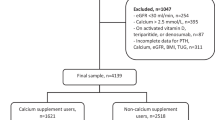Abstract
Proton pump inhibitors (PPIs) are a commonly prescribed class of medications. Their use has been associated with an increased rate of fractures, most notably hip fractures. However, there does not seem to be a clear association between PPI use and bone mineral density measurements, assessed by dual X-ray absorptiometry. The mechanism by which PPI use increases the risk of fractures remains unclear. This review will summarize the current evidence on this topic.
Similar content being viewed by others
References
M.L. Schubert, D.A. Peura, Control of gastric acid secretion in health and disease. Gastroenterology 134(7), 1842–1860 (2008)
A.B. Thomson et al., Safety of the long-term use of proton pump inhibitors. World J. Gastroenterol. 16(19), 2323–2330 (2010)
S. Dial et al., Use of gastric acid-suppressive agents and the risk of community-acquired Clostridium difficile-associated disease. JAMA 294(23), 2989–2995 (2005)
R.J. Laheij et al., Risk of community-acquired pneumonia and use of gastric acid-suppressive drugs. JAMA 292(16), 1955–1960 (2004)
M.D. Howell et al., Iatrogenic gastric acid suppression and the risk of nosocomial Clostridium difficile infection. Arch. Intern. Med. 170(9), 784–790 (2010)
A. Deshpande et al., Association between proton pump inhibitor therapy and Clostridium difficile infection in a meta-analysis. Clin. Gastroenterol. Hepatol. 10(3), 225–233 (2012)
N.R. Rozgony et al., Vitamin B(12) deficiency is linked with long-term use of proton pump inhibitors in institutionalized older adults: could a cyanocobalamin nasal spray be beneficial? J. Nutr. Elder 29(1), 87–99 (2010)
K.L. Insogna, The effect of proton pump-inhibiting drugs on mineral metabolism. Am. J. Gastroenterol. 104(Suppl 2), S2–S4 (2009)
H. Koop, Review article: metabolic consequences of long-term inhibition of acid secretion by omeprazole. Aliment. Pharmacol. Ther. 6(4), 399–406 (1992)
S.A. Wainwright et al., Hip fracture in women without osteoporosis. J. Clin. Endocrinol. Metab. 90(5), 2787–2793 (2005)
S.R. Cummings et al., Risk factors for hip fracture in white women. Study of Osteoporotic Fractures Research Group. N. Engl. J. Med. 332(12), 767–773 (1995)
S.P. Marcuard, L. Albernaz, P.G. Khazanie, Omeprazole therapy causes malabsorption of cyanocobalamin (vitamin B12). Ann. Intern. Med. 120(3), 211–215 (1994)
J.R. Lewis et al., Long-term proton pump inhibitor therapy and falls and fractures in elderly women: a prospective cohort study. J. Bone Miner. Res. 29(11), 2489–2497 (2014)
E. Salgueiro et al., Safety profile of proton pump inhibitors according to the spontaneous reports of suspected adverse reactions. Int. J. Clin. Pharmacol. Ther. 44(11), 548–556 (2006)
B.M. Kuschel, L. Laflamme, J. Moller, The risk of fall injury in relation to commonly prescribed medications among older people-a Swedish case–control study. Eur. J. Public Health (2014). doi:10.1093/eurpub/cku120
K. Zhu et al., ‘Timed up and go’ test and bone mineral density measurement for fracture prediction. Arch. Intern. Med. 171(18), 1655–1661 (2011)
S.L. Gray et al., Proton pump inhibitor use, hip fracture, and change in bone mineral density in postmenopausal women: results from the Women’s Health Initiative. Arch. Intern. Med. 170(9), 765–771 (2010)
L.E. Targownik et al., Proton-pump inhibitor use is not associated with osteoporosis or accelerated bone mineral density loss. Gastroenterology 138(3), 896–904 (2010)
D.H. Solomon et al., Bone mineral density changes among women initiating proton pump inhibitors or H2 receptor antagonists: a SWAN cohort study. J. Bone Miner. Res. 30(2), 232–239 (2014)
G. Ioannidis et al., Relation between fractures and mortality: results from the Canadian Multicentre Osteoporosis Study. CMAJ 181(5), 265–271 (2009)
Y.X. Yang et al., Long-term proton pump inhibitor therapy and risk of hip fracture. JAMA 296(24), 2947–2953 (2006)
B. Abrahamsen, P. Vestergaard, Proton pump inhibitor use and fracture risk—effect modification by histamine H1 receptor blockade. Observational case–control study using national prescription data. Bone 57(1), 269–271 (2013)
J. Ding et al., The relationship between proton pump inhibitor adherence and fracture risk in the elderly. Calcif. Tissue Int. 94(6), 597–607 (2014)
L.M. Moberg et al., Use of proton pump inhibitors (PPI) and history of earlier fracture are independent risk factors for fracture in postmenopausal women. The WHILA study. Maturitas 78(4), 310–315 (2014)
J. Lee et al., A population-based case–control study: proton pump inhibition and risk of hip fracture by use of bisphosphonate. J. Gastroenterol. 48(9), 1016–1022 (2013)
D. Prieto-Alhambra et al., Predictors of fracture while on treatment with oral bisphosphonates: a population-based cohort study. J. Bone Miner. Res. 29(1), 268–274 (2014)
J.A. Kanis et al., FRAX and the assessment of fracture probability in men and women from the UK. Osteoporos. Int. 19(4), 385–397 (2008)
P. Vestergaard, L. Rejnmark, L. Mosekilde, Proton pump inhibitors, histamine H2 receptor antagonists, and other antacid medications and the risk of fracture. Calcif. Tissue Int. 79(2), 76–83 (2006)
F. de Vries et al., Fracture risk in patients receiving acid-suppressant medication alone and in combination with bisphosphonates. Osteoporos. Int. 20(12), 1989–1998 (2009)
E.W. Yu et al., Proton pump inhibitors and risk of fractures: a meta-analysis of 11 international studies. Am. J. Med. 124(6), 519–526 (2011)
D.P. Kiel et al., Health care utilization and functional status in the aged following a fall. Med. Care 29(3), 221–228 (1991)
Conflict of interest
Arthur Lau: Honorariums/Consultations: Amgen, Abbvie, Roche, UCB, Celgene; Stocks: None to declare. Jonathan D. Adachi: Honorariums/Consultations: Amgen, Merck Frost Canada, Eli Lilly, Warner Chilcott; Stocks: None to declare. Michael Tomizza: None to declare. Matthew Wong Pack: None to declare. Alexandra Papaioannou: Honorariums/Consultations: Amgen, Merck Frost Canada, Eli Lilly, Warner Chilcott, Novartis.
Author information
Authors and Affiliations
Corresponding author
Rights and permissions
About this article
Cite this article
Lau, A.N., Tomizza, M., Wong-Pack, M. et al. The relationship between long-term proton pump inhibitor therapy and skeletal frailty. Endocrine 49, 606–610 (2015). https://doi.org/10.1007/s12020-015-0576-z
Received:
Accepted:
Published:
Issue Date:
DOI: https://doi.org/10.1007/s12020-015-0576-z




